Philodendron Melanochrysums (Also known as the Black Gold Philodendron) have become the Philodendron of envy for many when viewing Instagram plant accounts over the past couple of years. The Melanochrysum is a stunning-looking tropical houseplant that likes to climb with beautiful dark green velvety-like leaves that make just about anyone stop and stare. The Philodendron Melanochrysum can be somewhat easy to care for, however, there are other Philodendrons that don’t require as much attention. Read on if you would like to find out more about Philodendron Melanochrysum care in this plant care guide.
Find other Philodendron Care Guides here.
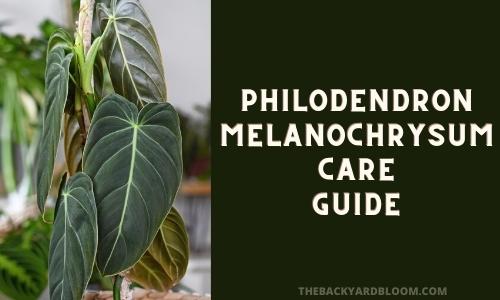
Origins
The Melanochrysum originates from the tropical forests of Columbia, mainly in the provinces of Chocó and Antioquia. It has been cultivated since the late 1800s, originally being called Philodendron grandidens.
These plants normally start out growing along the forest floor until they find a tree to climb up. Once they start climbing upwards, the leaves start to grow bigger and the plant enters its mature phase. In its natural habitat, it has been known to grow over 20 feet in height with leaves up to 3 feet long.
Other Names for the Philodendron Melanochrysum
- Black Gold Philodendron
- Velour Philodendron
- Philodendron andreanum
- Philodendron grandidens
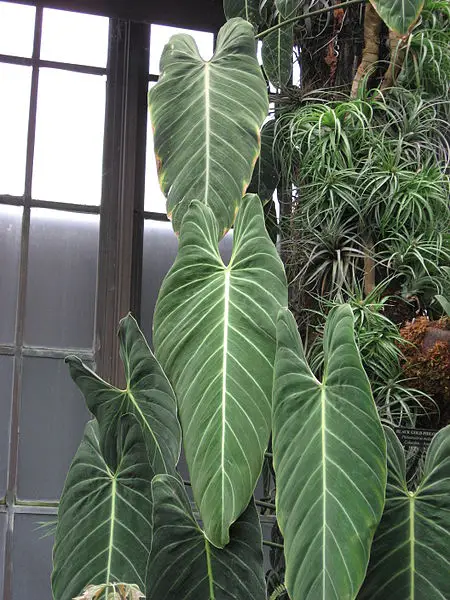
Philodendron Melanochrysum Care – Quick Overview
- Bright Indirect Light, but can tolerate medium light areas, avoid direct sun.
- Allow your Philodendron Melanochrysum to climb in order to reach its mature state.
- Let the top couple of inches of soil dry between watering.
- Use a well draining potting mix and a pot that allows for drainage.
- Warm temperatures are best with high humidity.
- Toxic to pets.
Water Needs
While they are from the tropical forest, the majority of the roots after the plant has started to climb are not in soil and instead are on the sides of trees. So you don’t want the plant to always be in moist soil.
Allow the top few inches of soil to dry out between waterings. When you do water the plant make sure that the water is at room temperature. Watering your plant with cold water can shock the root system, as can hot water.
Overwatering can lead to yellow leaves and then they will then fall off. It can also cause root rot if the plant is left sitting in soil that is always soggy. Root rot is hard to recover from for any plant.
Philodendron Melanochrysum Light Requirements
The Philodendron Melanochrysum can live in both bright and medium-lit areas. They are used to being under the cover of bigger trees so they are not a plant for direct sun.
For the Melanochrysum to thrive, it needs to have bright indirect light or filtered sunlight. Having bright light will allow the leaves on a Melanochrysum to grow bigger and the plant will also grow faster.
They can still adapt to medium light, but they will not grow as fast and will have a harder time maturing.
Other Philodendron Care Guides:
- Silver Sword Philodendron Care Guide
- Philodendron Burle Marx Care
- Philodendron Billietiae Care Guide
- Philodendron Birkin Care Guide
- Philodendron Brasil Care Guide
- Philodendron Dark Lord Care
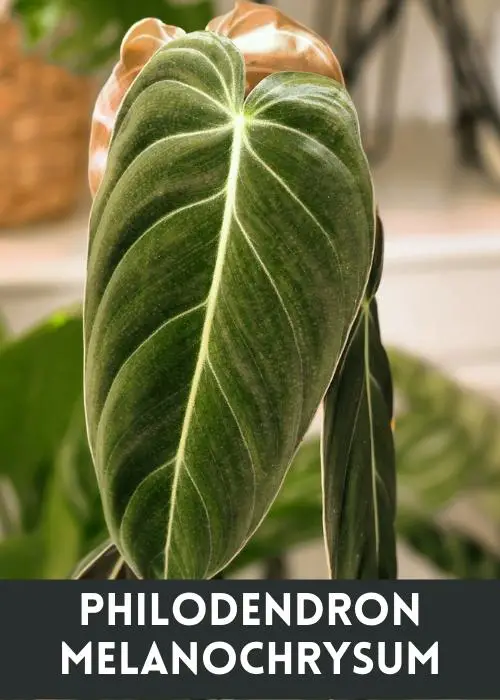
Temperature
These plants love warmer temperatures and are happy in temperatures ranging from 65 F to 80F. Don’t let the temperature drop below 55 F. Too low of a temperature can cause the growth of the plant to be stunted. Black spots can also appear on the leaves if the temperature is dropping too low.
Philodendron Melanochrysum Humidity
The Melanochrysum needs high humidity and it is very important for humidity levels to be high (greater than 60%) for them to grow well. Many owners of Philodendron Melanochrysums will use humidifiers in the room that they have their plant in. The higher the humidity the better.
Having higher humidity levels is essential for the aerial roots that the Philodendron Melanochrysm puts out as it climbs. Low humidity levels will cause the aerial roots to dry up. Also, without high humidity levels, the growth rate will slow.
Philodendron Melanochrysum Soil Mix and Pots
The best mix for soil for a Philodendron Melanochrysum is one that is equal parts of regular potting mix, orchid potting soil, and perlite. But if you don’t have orchid potting soil available you can use a mix of regular potting soil and perlite, or succulent soil mix.
The main thing when picking out soil for your Philodendron Melanochrysum is a well-draining soil. You want the plant to have access to some of the moisture from the water you give it but you don’t want the soil hanging on to all of the water and causing root rot to start. Using perlite is essential in your soil medium.
For the pot, you want one that has good drainage. People have luck in many different types of pots for these plants. Terracotta pots are usually preferred among owners of these plants.
Philodendron Melanochrysum Fertilizer
Fertilizer amounts will depend on the light levels that your plant is in. When you have your plant in bright light it will need more fertilizer. For lower light levels it will need less.
Liquid fertilizers are great to use for this plant.
During the spring and summer fertilize the plant once a month with the amount on the container of the fertilizer you choose if it is in bright light. You could also cut the amount of fertilizer in half and apply it every two weeks.
If your plant is in a medium-light setting cut the amount of fertilizer in half.
During the fall and winter it is best to not fertilize the plant unless you start to notice some signs of nutrient deficiency on the leaves.
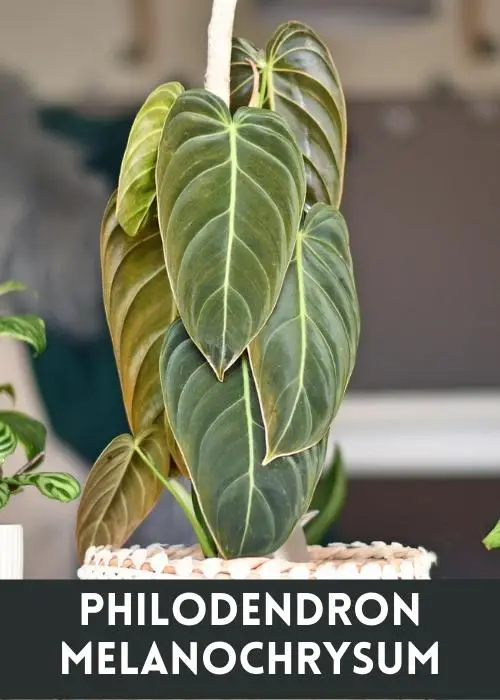
Propagation
You can propagate Philodendron Melanochrysum plants using both soil or moss, and water propagation. You will need a set of sterilized scissors or blade, sphagnum moss or potting soil, and a small pot/nursery container.
The first step for propagating a Philodendron Melanochrysum is to get a stem cutting. You will want to identify the nodes on the plant, this is where the leaf comes out of the vine. You will often see areal roots at these sections, they will be small little bumps when the plant is young.
Once you have identified where the nodes are, take a cutting about one inch from each side of the node. By making the cuttings this way you can get a cutting for each leaf.
When propagating in soil or moss, plant your cuttings with the nodes about a half-inch under the sphagnum moss or soil medium. Sometimes during propagation growers will find that the initial leaves will rot or die off. This is ok and the cutting will still start new growth and take root. This can often happen when under a humidity dome.
After a few weeks go by you should start to see small roots sprouting from the cuttings. Once they have grown to at least an inch long you can transplant the cutting into a regular pot and soil mixture. Make sure to keep the soil moist at this stage to encourage more growth. Once a few more weeks have gone by you can start to water the plant less allowing the top few inches of the soil to dry out.
If you are propagating in water, you follow the same process but put your cutting in water instead of planting it in soil.
Propagation Tips
- Soil/Moss propagation works better than water propagation.
- Humidity is essential for successful propagation.
- Using clear cups instead of a pot is useful to keep an eye on root development during propagation.
Philodendron Melanochrysum Growth Rate
How fast does the Philodendron Melanochrysum grow? They can have a fairly fast growth rate during the summertime when they have abundant light and get fertilized as needed.
The growth rate slows down in the winter for these plants but it will not stop entirely. And the growth rate will also be slower when light levels are lower or humidity levels are too low.
Mature Philodendron Melanochrysum
When the plant is mature the leaves can grow up to 3 feet long outdoors in its natural habitat. But indoors the leaves can be smaller, but still very big for a houseplant. It can take several years for them to reach their full size and they must be able to climb vertically to reach their full size.
Juvenile Philodendron Melanochrysum
When the plants are young they have smaller leaves that are usually a coppery color when they first appear.
They will also stay in this juvenile state with smaller leaves if they are not allowed to climb and are kept as a trailing plant.
Pests
Spider Mites
While Philodendron Melanochrysums are not very susceptible to pests, one that they can get is spider mites.
If you see spider mites on your plant make sure to treat them plant for them right away with insecticidal soap or neem oil.
Common Problems
Yellow Leaves
The most common reason that a Philodendron Melanochrysum would start to get yellow leaves is due to overwatering. Make sure to let the top two inches of soil dry out between watering the plant.
Brown Leaves
If the leaves of your Philodendron Melanochrysum are starting to turn brown and appear to feel crisp that is an indication that the plant needs more moisture or that it is getting burned from too much direct sun. Check the light of your plant and check soil moisture levels along with humidity in the area your plant is in.
If the brown leaves are old leaves and are falling off, this is a normal process. The main reason to be alarmed with brown leaves is if they are newer leaves.
Leggy
If your Philodendron Melanochrysum is growing leggy this is usually indicating that the plant needs more light. They will grow leggy as they try to reach for more adequate light levels. You will find sites often saying Philodendrons can do great in low light levels, and that is true for some species of Philodendrons but not for the Melanochrysum.
Drooping Leaves
Most often if the leaves are looking droopy and limp this is a sign that the plant needs more water. Low humidity levels could also be a factor especially if your Philodendron Melanochrysum has started climbing. Aerial roots use humidity in the air to take in moisture for the plant in addition to the roots that are in the pot using the water you give it. Without adequate humidity levels, this can lead to drooping leaves.
Frequently Asked Questions:
Yes, the Philodendron Melanochrysum does climb. For the plant to fully mature it is essential that it is allowed to climb. Many owners of this plant love to use a moss pole in the pot for the plant to climb up.
The Philodendron Melanochrysum is still a relatively rare plant to fine which leads to a more costly price. Since many of the bigger plant nursery companies have not started carrying this plant regularly it is often only available from smaller plant growers. If your local nursery doesn’t have any you can always check Etsy for Philodendron Melanochrysums as it is a very popular place to get rare plants.
Yes, the Philodendron Melanochrysum is toxic to pets. According to the ASPCA all Philodendrons contain calcium oxalate crystals. Pets that chew or bite the plant can get irritation in their mouth and in their GI tract. Rarely there can be swelling of the upper airway.
The Philodendron Melanochrysum leaves get bigger as the plant climbs. To make sure your plant is able to grow bigger leaves you must have something for it to climb up as it grows. Most plant owners prefer moss poles for the Philodendron Melanochrysum.
No Philodendron Micans and Melanochrysums are not the same plant. When Melanochrysums are juveniles they look similar and often get mistaken for the other at this stage. Micans are a vining Philodendron while Melanochrysums are a climbing Philodendron. Micans are common to see in plant nurseries and even big box stores. You can see the difference between the two in the image below.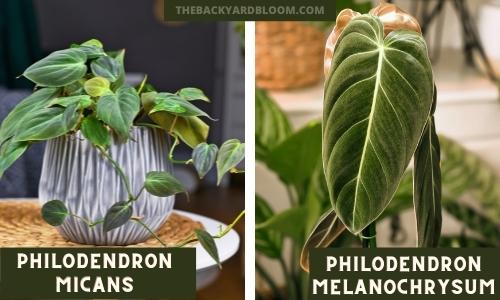
References
- Philodendron melanochrysum Linden & André; https://powo.science.kew.org/taxon/urn:lsid:ipni.org:names:87882-1
- Philodendron, ASPCA; https://www.petpoisonhelpline.com/poison/philodendron/